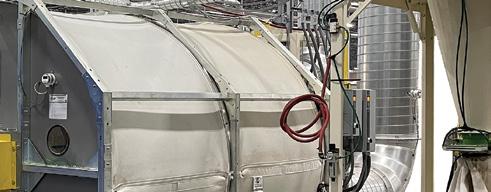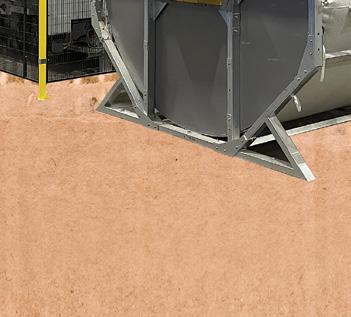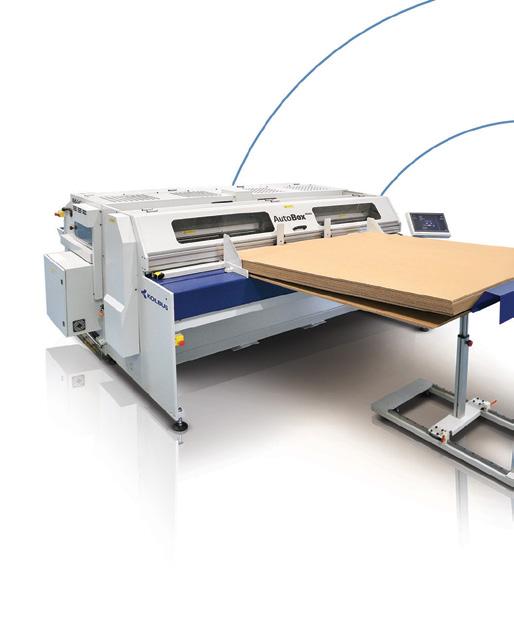
10 minute read
SELLING TODAY
Material Testing and Why You Need It Now
BY TOM WEBER
Advertisement
Ralph Young, my famous AICC counterpart serving the corrugated membership, and I recently co-hosted a webinar, aptly named Material Testing and Why You Need It Now! This subject has resonated with both of us for many years now, as more and more of our strategic raw materials are being sourced offshore, with little to no knowledge of exactly what waste papers, chemicals, and compounds are being used to manufacture them.
This is precisely why we felt it was imperative to remind all AICC members that there are certain tests that should be performed in-house to ensure that all customers are receiving a product that will meet their manufacturing production-line criteria. For the purpose of this article, I will refrain from any graphic testing devices and comment only on the key attributes regarding functional performance-testing equipment criteria. The purpose is to advise members of what testing I consider to be the most critical today. My top 10 tests are noted below in no particular order.
1. Sutherland Rub Test
• This test specifically identifies the ability of the substrate, inks, and coatings to withstand transit and handling. • The test can also be utilized to determine your best approach to meet your customer’s filling-line demands as well as storage and refrigerated/ frozen case concerns.
2. Score Bend Test
• This testing can afford you, the carton manufacturer, the peace of mind of knowing that you have properly scored the material to provide for the best possible cartoning outcome. • The data provided can allow for direct comparisons, as you need to compare and contrast various materials as substitutions become inevitable with continued supply chain woes.
3. Opening Force Test
• The force required to open a side-seam glued folding carton will be somewhat directly proportional to the score bend test above, as well as the degree of folded score pre-break that is set up on your gluing lines. • The style of the carton blanks, along with your gluing parallel score pressure wheels, can be tremendous aids and can allow you to provide your customers with easy-opening cartons for extended periods of time.
4. Slip Angle/Coefficient of Friction Test
• This inclined plane device will afford you the opportunity to gauge how effectively you have applied the coating to the carton surface—and how well you have cured it. • This test is critical to ensuring good carton filling-line performance and should be set up using data established from well-running carton blanks.
5. Dyne Test
• This test is usually prescribed for more nonporous materials, such as plastics and other nonwoven materials. I have found it to be particularly useful to test incoming lots of papers and paperboards to determine their specific “holdout” characteristics. • The data obtained can be crossreferenced with the slip angle, glue seam tensile pull, and gloss testing to tell a full story about that lot of material.
6. Glue Seam Test
• This test is usually performed in a tensile pull device and gauges the force required to delaminate either the glue strip from the paperboard or the paperboard itself—weakest bond loses. • Folding cartons that are packaged heavily or tend to light caliper and
“football” around the middle can succumb to a weakened glue bond or too thin an adhesive glue line. This device also can easily compare and contrast various adhesives (hot melt, cold dextrin, cold resin, etc.).
7. Cady Gauge Caliper Test
• The use of a calibrated micrometer is essential to good carton-making.
It should have a minimum of a 1-foot-diameter piston and preferably be motorized to eliminate any heavyhanded device operation. • A deep-throated Cady gauge will also allow the checking of folded score
parallel to ensure that your carton will stack and pack well, as well as function on the customer’s fi lling lines. Th e three most critical measures are near score, far score, and the glue seam. Th e glue seam sets the bar, and then the far score should match that number, with the near score (closest to the glue seam) set at or below by 0.001–0.002 to ensure proper stack height is maintained in the customer’s cartoner hopper/feeder magazine.
8. Perforation Puncture Test
• Th is test is often executed using a motorized Chatillon force gauge mounted to a fi xture with an appropriate fi xture on the end, sized to replicate the perforated tab desired for testing. It will create a data point when testing a properly functioning tear tab to ensure reliability both
from run to run and during a run of folding cartons. • Th e need to maintain a properly functioning tear tab across multiple die positions on a folding carton tool set dictates the use of such a device to quantify results for GMP.
9. Light Box Test
• A light box, used to see exactly how well perforations and cut scores are being manufactured, is a useful tool that I have at the press side on the die cutter or in-line web press. • Th is gives the operator a quick visual reference to compare die positions once again and gauge the cutting-rule eff ectiveness. A dull perforation rule is very easily noticed with light penetration before it may be felt in the typical carton checks of each die position.
10. Gloss Meter
• As mentioned above, this is a print quality device for certain. It is also a measure of the material itself as far as ink and coating holdout is concerned.
With the multitude of raw materials we are using these days, I encourage all to utilize the gloss meter instrument to properly document gloss measurements during and between runs. • Over a period of time and across multiple materials, you may begin to see patterns you both do and do not care for. Either way, you will be informed and armed to do battle.
Tom Weber is president of WeberSource LLC and is AICC’s folding carton and rigid box technical advisor. Contact Tom directly at asktom@aiccbox.org.









Death of the Traditional Sales Process
BY TODD M. ZIELINSKI AND LISA BENSON
There have been significant advances in manufacturing productivity in the past century. Historically, production operated under a make-to-stock environment, and it was the salesperson’s job to sell the product. Traditional sales principles worked well under that model and still may for some industries with transactional sales environments. For complex sales, however, the traditional sales process is changing (some might say slowly dying).
The traditional sales model operates with the following principles: • Large sales require personal relationships. • Salespeople are encouraged to view their territory as their own business and operate autonomously. • Sales is primarily an outside activity. • More salespeople are needed to increase sales.
Complex selling environments require a better method to run efficiently and fill the sales pipeline with a scalable number of solid, qualified leads. Today, competition is fierce in the custom packaging industry. Manufacturing equipment advancements, improved materials, and customer demands have led many packaging manufacturers to turn to a custom-built model. Under this model, the traditional sales principles are not always the most effective or productive, although many manufacturers are still operating under these misconceptions.
Misconception – Large Sales Require Personal Relationships
Like the chicken and the egg, we must ask which came first—the relationship or the sale? In all honesty, the relationship likely came after the first sale.
The relationship might be a factor in customer retention (repeat transactions); however, on-time delivery, quality, pricing, and return on investment are generally the primary influences. Usually, when qualified prospects show interest, it’s because they have an issue in one or more of these areas causing them pain (related to time, resources, dollars), not because they are looking for a relationship. “Relationship selling” implies that a company has no other differentiators and must rely on the relationship. The pandemic lockdowns forced some companies to look at the value they provide their customers and, as a result, they have had to shift their selling tactics to successfully close large sales opportunities without face-to-face interactions.
Misconception – Salespeople Should Operate Autonomously
In a traditional model, salespeople sell products from inventory and require little interaction with production. In a custom-built model, the salesperson can sell only what the design teams and production have the capacity for, so all must work closely together.
Misconception – Sales Is Primarily a Field Activity
In the traditional sales model, outside, or “field,” salespeople were the norm. Before computers and cellphones, it made sense to have your entire team doing outside sales. While there is still a need for face-to-face activities (and some industries may depend on them more heavily), the majority of work for packaging manufacturers isn’t done in front of the customer.
Today’s selling model requires that selling is no longer primarily a field activity. It is mainly an inside activity with a few distinct functions performed outside. Prospect vetting, quoting, proposals, designing, scheduling, and administrative tasks don’t require a field visit. The same is true for repeat transactional sales.
Misconception – More Salespeople Are Needed to Increase Sales
When looking for sales growth, many manufacturers mistakenly believe that hiring more salespeople will lead to more sales. This isn’t usually the case. In fact, many who change to this new sales model find they need fewer salespeople (full-time reps) to experience increased sales growth. If your production system is running inefficiently, adding more equipment and hoping that fixes the problem doesn’t always make the most sense. Sales should be treated just like any production operation that requires the assessment and execution of required, ongoing process-improvement tactics.
Division of Labor
Today, many customers have limited time and prefer a more efficient online or virtual interaction. Customers will spend most of the sales cycle researching on their own before reaching out. Many will read content on websites and contact packagers through website forms or electronic communications. Some customers are less interested in meeting a salesperson until the end of the process, if at all. Often, by the time they reach out, a customer already has a direction in mind and, in some cases, a decision has already been made.
This is why salespeople today typically spend the majority of their time doing activities that do not involve the active sales process. The average salesperson has only a few customer meetings a week and is heavily involved in customer service and
administrative tasks. Current compensation practices often inadvertently encourage them to service some accounts heavily and ignore others. Many salespeople either can’t or don’t prospect enough to generate the required sales numbers management would like. Because of this current sales reality, sales can be very fragmented, negatively impacting their sales productivity and results. Because of the autonomy, there is often friction between sales and other departments. In addition, some salespeople are in roles that don’t suit their personality traits (preferences/skill sets)—traits that are required to prospect effectively.
All of these issues can lead to the sales department being inefficient and unproductive. By employing a division-of-labor process, your sales team can become more efficient and can close more meaningful sales.
Division of labor was introduced by Adam Smith in the late 18th century as a method for dividing production into different tasks performed by different people. The method is used to increase productivity and output. This same process can actually be used for complex, custom (technical) sales by dividing the sales tasks among people to allow more focus in each area. Division of labor can increase opportunity flow and active sales opportunities.
The division-of-labor model may look a bit different in various companies, but here is one example of how it might work for a packaging company.
Customer service is responsible for customer support, such as dealing with complaints. It also handles low-dollar transactions from both current customers and new accounts. Account managers are responsible for customer retention and growth for medium to large customers. The marketing coordinator handles content creation, developing sales materials, emails, webinars, blogs, and social media and web content, and provides inbound (search engine optimization/pay-per-click) leads to inside sales for vetting.










